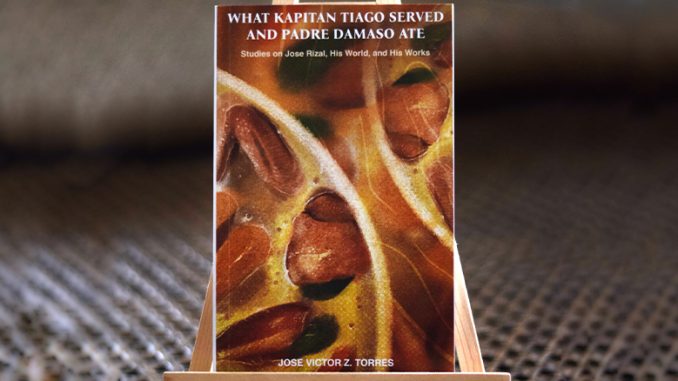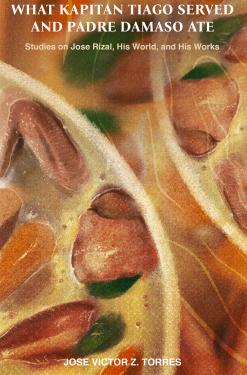
Title: What Kapitan Tiago Served and Padre Damaso Ate: Studies on Jose Rizal, His World, and His Works
Author: Jose Victor Z. Torres
Quezon City: BUGHAW/Ateneo de Manila University Press (2021)
In his review of José Rizal’s Noli Me Tangere (trans. Soledad Lacson-Locsin), Benedict Anderson had placed Rizal at the center stage of global history. An important revolutionary figure of the century from Asia, Rizal was indeed a product of some of the remarkable events in Europe, for instance, the triumph of liberalism in Spain, that duly had effects in the colony. Most noticeable was how Anderson painted Rizal on the same canvas of intellectuals like Gandhi, Sun Yat-sen, Lenin, among others. Anderson was ultimately introducing Rizal into a wider readership of non-Filipinos. 1 This is the same direction of Jose Victor Z. Torres’s new book titled, What Kapitan Tiago Served and Padre Damaso Ate: Studies on Jose Rizal, His World, and His Works. A collection of essays that reintroduces Rizal by “discussing the world that Rizal lived in and how it influenced his ideas, his works, and his writings (xvi).”
The book is composed of five short-length essays that Torres has presented to both the general public and his students within the span of his long career of teaching ‘The Life and Works of Rizal’ in one of the leading universities in the Manila heartland. Also known as Rizal Course, it is a mandated-by-law lecture course in the Philippines. Every Filipino is required to learn about the life of Rizal and read his two novels, political and historical writings, and sometimes his poems, to infuse a love of the country, or simply nationalism. A great addition to the growing literature on Rizal and perhaps, future teaching material for Rizal Course, Torres wanted to take Rizal out of his heroism and focus more on the narrative of being a creation of the “century of change” (xvi-xix).
 The chapters “What Kapitan Tiago Served and Padre Damaso Ate,” “Escandaloso, Horrendo, y Punible Delito…” and “A la Juventud de Filibusteros,” are reexamination of Rizal’s two famous novels, Noli Me Tangere and El filibusterismo. While the two novels have long been regarded as a key text of fanning the flames of nationalism in the nineteenth century, a recent study theorized that the novels were more ‘social portraits’ of Rizal’s epoch. In his Noli and El fili, Rizal has exposed the social ills of the colony through allegory. 2 Torres embarked on the same premise. The Noli, for instance, in his research, was also an important sociocultural document that had bits of information about Philippine cuisine of the period (15). Though the events in the novel were certainly fictitious, some happenings in the Noli, according to Torres, were based on actual events. Rizal might have included these anecdotes to mirror his work with the defining spirit of the period. But Torres also suggests that because of their anti-clerical motifs, these events were used for propaganda purposes to discredit and denounce the colonizers (39). In these chapters, we can conclude that Torres was successful in adding more flavor to Rizal’s enjoyed recognition as a literary genius.
The chapters “What Kapitan Tiago Served and Padre Damaso Ate,” “Escandaloso, Horrendo, y Punible Delito…” and “A la Juventud de Filibusteros,” are reexamination of Rizal’s two famous novels, Noli Me Tangere and El filibusterismo. While the two novels have long been regarded as a key text of fanning the flames of nationalism in the nineteenth century, a recent study theorized that the novels were more ‘social portraits’ of Rizal’s epoch. In his Noli and El fili, Rizal has exposed the social ills of the colony through allegory. 2 Torres embarked on the same premise. The Noli, for instance, in his research, was also an important sociocultural document that had bits of information about Philippine cuisine of the period (15). Though the events in the novel were certainly fictitious, some happenings in the Noli, according to Torres, were based on actual events. Rizal might have included these anecdotes to mirror his work with the defining spirit of the period. But Torres also suggests that because of their anti-clerical motifs, these events were used for propaganda purposes to discredit and denounce the colonizers (39). In these chapters, we can conclude that Torres was successful in adding more flavor to Rizal’s enjoyed recognition as a literary genius.
The two chapters, however, that are more interesting are “Telegrafo, Electricidad, y Poste de Luz” and “Annotating Colonial Histories.” The former is a sketch of the modernization of the nineteenth century that mainly shaped Rizal’s intellectual and personal life, while the latter is a reassessment of Rizal’s sojourn in the English capital and his attempt there to reinterpret the history of the Philippines, annotating a 1609 book Sucesos de las Islas Filipinas by Antonio de Morga.
Telegrafo, Electricidad, y Poste de Luz, or translated in English as telegraph, electricity, and lamppost, is an essay that makes Rizal more human than a hero that most Filipinos have recognized him to be. Torres describes in this essay how Rizal mirrors today’s Filipino youth in this age of globalization: a student, a traveler, and a revolutionary (25). The piece is also the author’s personal reflection of researching and teaching Rizal over the years, and how he had developed a way of making Rizal more accessible to the present generation and to a non-Filipino audience, “instead of factbook lessons” about him (22).
In Annotating Colonial Histories, Torres has been more adept at narrating. As a trained historian, Torres tackled Rizal’s chronological travelogue and his intellectual history in annotating Morga’s Sucesos. The annotated Morga, or Rizal’s edition, is seldom read or, worse, ignored. But as Torres suggests, the importance of Rizal’s edition of Morga lies in the attempt to construct a “Filipino” interpretation of the history of Spain’s precious-but-neglected colony, the Philippines. This effort was more than a nationalist reinterpretation, as Nicole CuUnjieng-Aboitiz notes, in her book Asian Place, Filipino Nation: A Global Intellectual History of the Philippine Revolution, 1887-1912, Rizal’s edition of Morga was a declaration of incorporating a Philippine civilization within the grounds of a broader Malay civilization. 3 However, this attempt by Rizal and his fellow Filipino reformists like Isabelo de Los Reyes and Pedro Paterno of reconstructing a Philippine civilization was more an upshot out of propaganda than history, despite their scholarly undertaking. Yet Rizal’s stay in London was integral in the transformation of his intellectual maturity (58-63).
Alongside public historian Ambeth Ocampo, who has written extensively on Rizal and to whom the author has dedicated this book, Jose Victor Z. Torres has upheld in this collection of essays, that he is one of the leading historians, at present, writing on Rizal beyond the scope of nationalism. The essays are compelling to read as supplementary material for teaching Rizal in university and handy to introduce the national hero to a non-Filipino readership. Rizal, after all, was a product of global history.
Reviewed by Luis Zuriel P. Domingo
Luis Zuriel P. Domingo is lecturer of history at the University of the Philippines Baguio.
Notes:
- Benedict Anderson, “First Filipino,” London Review of Books 19, no. 20 (October 1997). ↩
- Emmanuel Jeric Albela and Antonio Hila, “Rizal, The Social Portraitist,” Philippine Social Science Journal 3, no. 1 (January-June 2020): 155-172. ↩
- Nicole CuUnjieng Aboitiz, Asian Place, Filipino Nation: A Global Intellectual History of the Philippine Revolution, 1887-1912 (New York, NY: Columbia University Press, 2020). ↩
